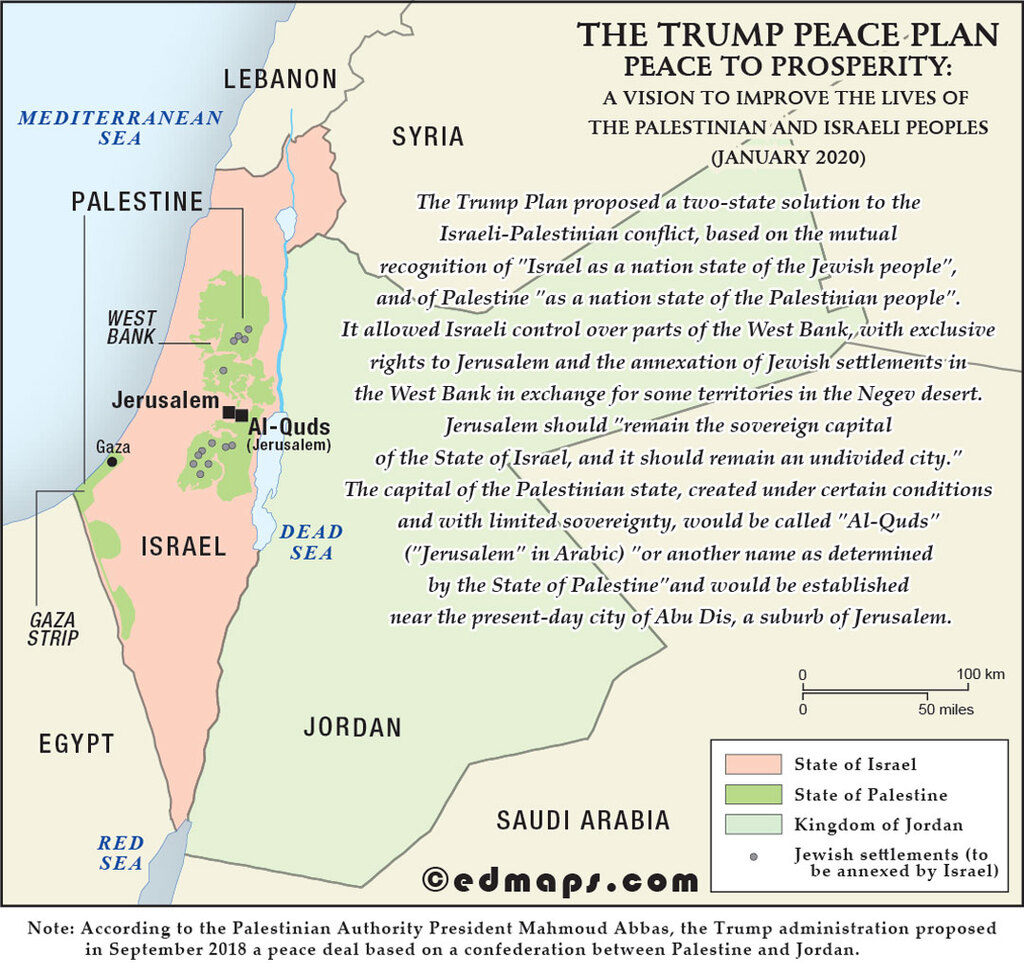
The Trump Plan for Palestine, unveiled January 28, 2020, proposed a Palestinian state with limited sovereignty, encompassing about 70% of the West Bank, connected to Gaza via tunnels or rail. Israel would annex the Jordan Valley, most settlements, and retain control over Jerusalem as its “undivided” capital, with a Palestinian capital in East Jerusalem’s outskirts (e.g., Abu Dis). Palestinians would receive Negev desert land as compensation. The plan allowed Israeli security oversight, demilitarized Palestine, and no Palestinian right of return to Israel. It was rejected by Palestinian leaders as favoring Israeli interests.

The unveiling of the Trump Administration's Middle East peace plan on January 28, 2020, represented one of the most ambitious yet contentious attempts to resolve the Israeli-Palestinian conflict in decades. Officially titled "Peace to Prosperity: A Vision to Improve the Lives of the Palestinian and Israeli People," the plan emerged after three years of development by President Donald Trump's senior advisor Jared Kushner and represented a dramatic departure from previous American-mediated peace initiatives. Unlike earlier proposals that sought to balance competing claims, the Trump Plan openly acknowledged Israeli territorial gains while offering Palestinians a pathway to limited statehood under highly constrained conditions.
The plan's territorial arrangements reflected a stark asymmetry in favor of Israeli interests. While proposing the creation of a Palestinian state, this entity would encompass only approximately 70% of the West Bank, with crucial areas remaining under Israeli control. Israel would be permitted to annex the strategically vital Jordan Valley, which comprises nearly 30% of the West Bank and serves as a natural defensive barrier. Additionally, most Israeli settlements throughout the West Bank would be incorporated into Israel proper, legitimizing decades of settlement expansion that had been considered violations of international law by much of the global community.
Jerusalem's status represented perhaps the most controversial aspect of the proposal. The plan designated Jerusalem as Israel's "undivided" capital, effectively endorsing Israeli sovereignty over the entire city, including East Jerusalem, which Palestinians have long claimed as their future capital. As compensation, Palestinians would be offered a capital in the outskirts of East Jerusalem, such as the town of Abu Dis, which lacks the historical and religious significance of Jerusalem proper.
The plan addressed Palestinian territorial losses through land swaps, offering areas in the Negev Desert as compensation for annexed West Bank territories. However, critics argued that this desert land was significantly less valuable than the fertile and strategically located areas being ceded to Israel. Connectivity between Palestinian territories would be maintained through tunnels or rail connections linking the West Bank to Gaza, though this infrastructure would remain subject to Israeli oversight.
Security provisions severely limited Palestinian sovereignty, requiring complete demilitarization and allowing Israeli security forces to maintain overriding authority. The plan explicitly rejected any Palestinian right of return to Israel, instead proposing that refugees be absorbed by the new Palestinian state or other countries, effectively ending decades of Palestinian aspirations for return to ancestral homes.
Palestinian leaders immediately rejected the proposal, denouncing it as heavily biased toward Israeli interests and incompatible with Palestinian national aspirations. The plan's failure to gain Palestinian acceptance, combined with changing political circumstances following Trump's electoral defeat, relegated this ambitious initiative to historical footnote status, though it demonstrated the persistence of American efforts to broker Middle East peace.